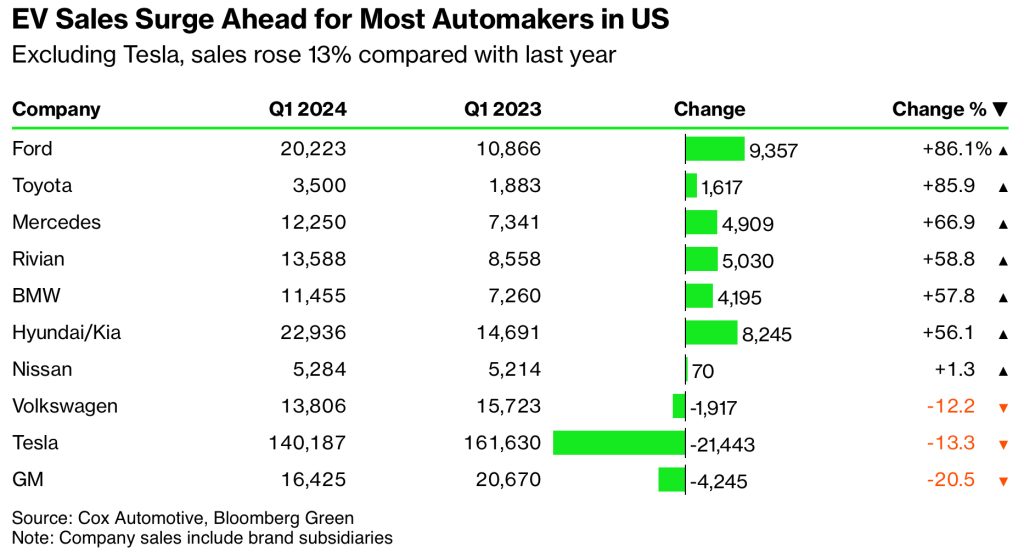EV sales continue to rise, but the last year of headlines falsely stating otherwise would leave you thinking they haven’t. After about full year of these lies, it  would be nice for journalists to stop pushing this false narrative that they could find the truth behind by simply looking up a single number for once.
would be nice for journalists to stop pushing this false narrative that they could find the truth behind by simply looking up a single number for once.
Here’s what’s actually happening: Over the course of the last year or so, sales of battery electric vehicles, while continuing to grow, have posted lower year-over-year percentage growth rates than they had in previous years.
This alone is not particularly remarkable – it is inevitable that any growing product or category will show slower percentage growth rates as sales rise, particularly one that has been growing at such a fast rate for so long.
In some recent years, we’ve even seen year-over-year doublings in EV market share (though one of those was 2020->2021, which was anomalous). To expect improvement at that level perpetually would be close to impossible – after 3 years of doubling market share from 2023’s 18% number, EVs would account for more than 100% of the global automotive market, which cannot happen.
Clearly, growth percentages will need to trend downward as a new product category grows. It would be impossible for them not to.
To take an extreme example, it would be odd to say that sales are slumping in Norway, which just set a record at 94% EV market share in August with 10,480 units moved, because BEV sales only went up 5% compared to the previous August’s 9,974 units.
And yet, this mathematical necessity has been reported time and time again in media, and by anti-EV political forces, as if EV sales are down, despite that they continue to rise.
The actual short-term status of EV sales – they’re still up
Instead of the perpetual 50% CAGR that had been optimistically expected, we are seeing growth rates this year of ~10% in advanced economies, and higher in economies with lower EV penetration (+40% in “rest of world” beyond US/EU/China). Notably, this ~10% growth rate is higher than the above Norway example, which nobody would consider a “slump” at 94% market share.
It’s also clear that EV sales growth rates are being held back in the short term by Tesla, which has heretofore been the global leader in EV sales. Tesla actually has seen a year-over-year reduction in sales in recent quarters – likely at least partially due to chaotic leadership at the wayward EV leader – as buyers have been drawn to other brands, while most of which have seen significant increases in EV sales.
 Brands saw big increases in EV sales in Q1, except Tesla, VW (prior to refresh of its one US EV model), and GM (after retiring its most-popular model). Source: Bloomberg
Brands saw big increases in EV sales in Q1, except Tesla, VW (prior to refresh of its one US EV model), and GM (after retiring its most-popular model). Source: BloombergThere are a number of other shorter-term influences, including a slowdown in Supercharger/NACS progressafter the entire charging team was fired which could be leading consumers to wait until the NACS transition is ready, political agitation by an ignorant presidential candidate which may cool after the election is finally over with and his fans’ short attention span moves elsewhere (pretty please), a misguided new tariff that has resulted in some automakers shuffling (and thus delaying) their plans, lack of available models for anyone who wants something other than a gigantic SUV, and limitations on EV tax credits (which are nevertheless bypassable).
Finally, some have suggested that this is a natural part of any technology adoption curve, as a technology transitions from being used by “early adopters” to “early majority.” Most consider the “chasm” between these groups to be somewhere around the 10-20% adoption range.
In terms of hybrid sales, much has been made of customers “shifting from EVs to hybrids,” which is also not the case. Conventional gas-hybrid sales are indeed up (as opposed to plug-in hybrids, which continue to lag behind gas-hybrids/BEVs, though have shown some growth lately), and gas-hybrids are up more than EV sales, after EV sales having had higher growth rates for many years than gas-hybrids have.
But gas-hybrid sales have not come at the cost of EV sales, but at the cost of gas-only car sales. Because EV sales are still up.
Media keeps pretending up is down
In covering these trends, some journalists have at least used the correct phrasing “slower growth,” showing that EV sales are still growing, but at a lower percentage change than previously seen.
But many, or perhaps even most, have taken the lazy – and incorrect – route of using descriptors that make it seem like sales have gone down, despite that they continue to go up.
This often takes the form of words like “cool” “fall” “slow” and “slump.” But none of these are accurate descriptors of still-rising sales.
All of these words would be best applied to a number that is decreasing, not to a number that is rising.
- If an object is thrown up in the air, it would not be described as “falling” until after it reaches the peak of its travel, despite that it is continually showing downward acceleration of 9.81m/s2 from the moment it is released.
- If today is hotter than yesterday, temperatures are not “cooling” even if the degree of temperature rise was lower than it was on the previous day (80º -> 85º -> 88º does not show a “cooling” trend).
- If a car goes 0-30 in 2 seconds, and 30-60 in 3 seconds, that car is not “slowing” from 30-60. It is still accelerating.
- If a graph shows a rising curve, that curve is not “slumping” before it reaches its peak. A “slump” would be better applied to a trough or nadir in the graph, not the zenith of it and certainly not anywhere in the runup to the zenith.
Indeed, the only way to make an argument that EV sales are “slowing” is to rely on the second derivative of sales numbers. Having to do integral calculus in order to suggest that sales are down, when sales are actually up, smacks of a certain level of desperation by a losing industry.
Gas car sales are actually going down
Because that’s just the thing: the number of gas-onlyvehicles being sold worldwide is a number that actually is falling. That number continues to go down year over year.
Sales of new gas-powered cars are down by about a quarter from their peak in 2017, and show no signs of recovering. It is exceedingly likely that 2017 will be the high-water mark of gas-powered cars ever sold on this planet.

And yet, somehow, virtually every headline you read is about the “EV sales slump,” rather than the “gas-car sales slump.” The latter is real, the former is incorrect.
These numbers are easily verifiable in moments. No matter what region of the world you’re in, EV sales are up in the first half of this year, and gas car sales are down. This has been true for most recent quarters when taking into account year-over-year numbers (the traditional way to measure car sales, since car sales are seasonal), and it’s true for the first half of this year so far– when the majority of these false headlines have been written.
Why does it matter? These lies influence policy – and cause more pollution
All of this matters because the constant incorrect reporting is causing changes in plans for both automakers and governments who are pulling back on EV plans, and contributes to incorrect consumer perceptions which in turn actually can affect demand, all of which dooms humanity to worse health and climate outcomes.
Early on as this pattern of lies started to show itself in the media, David Reichmuth of the Union of Concerned Scientists suggested that one motivation behind the false headlines could be to influence regulations. The idea goes that, by pretending EV sales were “cooling,” despite that they were not, automakers could convince governments to pull back on their future commitments, thus allowing automakers to continue business as usualinstead of having to put in effort to make actually good cars that don’t poison everything around them.
But those regulations already passed and timelines were loosened after automaker whining, so congratulations, you got what you wanted, you get to poison people a bit more for a few more years, and you can all stop lying now.
And yet, the headlines have continued, and so many outlets continue to push the same false narrative that they have for around a year now claiming that EV sales are down. Some number of consumers who hear these constant falsehoods may have their EV buying decisions delayed as a result, which could in turn actually be suppressing EVs below the even higher level that they would be at without so much incorrect reporting.
And yes, higher EV sales growth rates would be preferable to the current status quo and are needed to meet climate targets. Or rather, a faster decline in gas car sales is what’s truly needed – and would be beneficial to all living beings on this planet.
The environment cannot wait, and humans can’t spend the next 10-20 years breathing down the poison coming out of the tailpipe of each gas-powered vehicle sold today. This needs to end and it needs to end now. The faster we act, the easier it will be for the world to reach carbon reductions that are objectively necessary to achieve.
So stop lying about EV sales trends
But overall, the point of this article is that media headlines suggesting some slowdown in EV sales are simply incorrect. And it’s hard to imagine that these headlines, which have gone on for around a year now, are not intentional at this point.
Top comment by Lennart Andersson
Great article! Possibly many equate electric cars with Tesla.. I have five close friends that finally are getting electric cars within the last month. So in my limited sample of close friends it jumped from 20% to 50% in a month. Not a big sample but indicative that it is now hitting mainstream. One note is that none of them are a Tesla because of Musk's destructive social antics. Based on my limited sample people don't want to buy a car from him. Much because he is their sales department so they see Tesla=Musk.
Each journalist who has spent the last year perpetuating the myth of an EV sales slowdown could have read any one of our articles, or googled a single number showing year-over-year EV sales in any region or for most countries and most brands, and found that they are still going up. The information is out there and easy to find.
And if misinformation is done knowingly and intentionally despite ready access to truth, which is your job as a journalist to seek and find, it’s a lie.
So stop lying.










